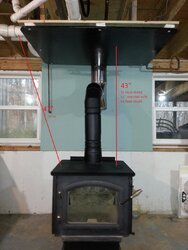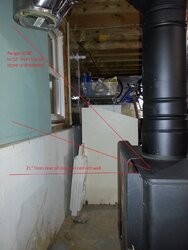first off can you hook a 8 in stove on to a 6 in chimney?
Next I am wondering about clearances. The stove I have now has low clearances and to get another one to fit in its place with bigger clearances can I put in a surround out of brick or durock and make that distance closer or do you have to keep a stove with larger clearances that far away no matter what. I guess what I am asking is when it says 17 inches from combustibles can I put it closer if it is bricked
Next I am wondering about clearances. The stove I have now has low clearances and to get another one to fit in its place with bigger clearances can I put in a surround out of brick or durock and make that distance closer or do you have to keep a stove with larger clearances that far away no matter what. I guess what I am asking is when it says 17 inches from combustibles can I put it closer if it is bricked




